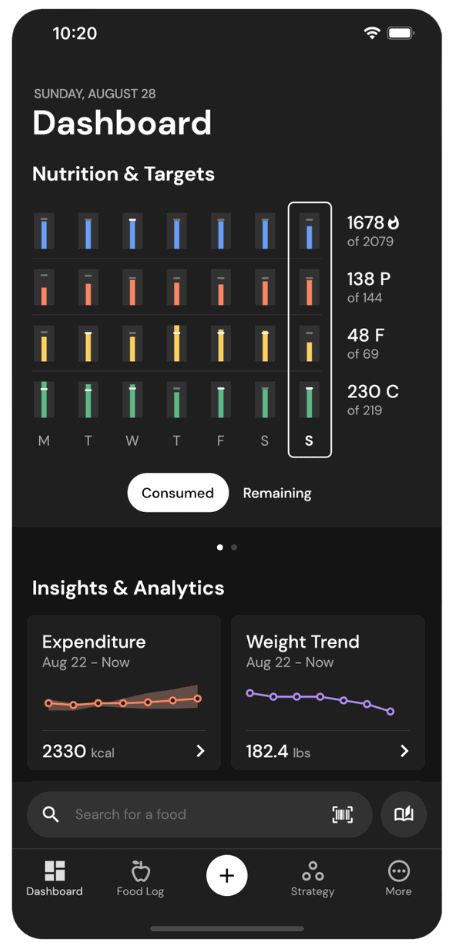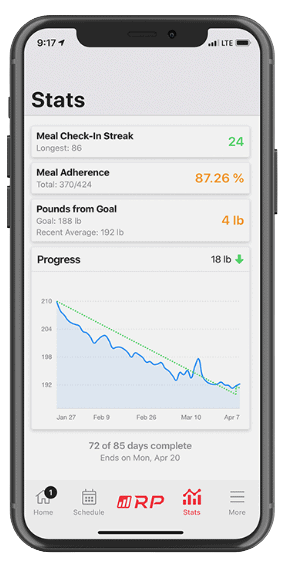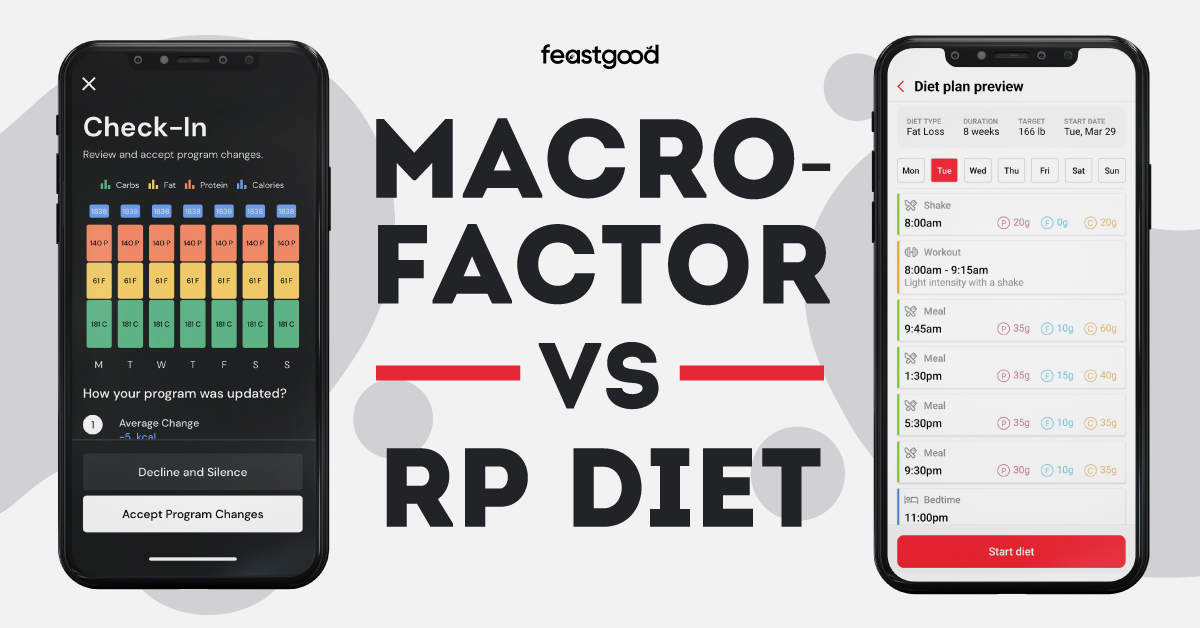Some links in this article are affiliate links, which means we earn from qualifying purchases. Learn more.
In the red corner is RP Diet–a meal-planning app designed by the respected Renaissance Periodization team (including Nick Shaw and Dr. Mike Isratel) to optimize body composition.
In the blue corner is MacroFactor––a macro tracker designed by Greg Nuckols, praised for its flexibility, accuracy, and coaching recommendations.
But which of the two is superior, and what are their unique benefits?
Key Takeaways
Honest Review Guarantee from FeastGood: Our testing team purchases each product 100% independently and uses the product for several weeks up to several months before writing a review. Learn more about our review process here.
- MacroFactor is superior to RP Diet in the head-to-head battle, with victories in 9 of the 10 key categories that were analyzed.
- MacroFactor is best for people who want more dietary freedom and the ability to track metrics (body measurements, progress photos, weight trends, etc.). The app is easy to use, intuitive, customizable, and perfect for both beginners and advanced macro trackers.
- The RP Diet is a rigid approach to dieting. It is best reserved for experienced macro-trackers who want precise guidelines for each meal and are okay with trading dietary flexibility for favorable results—e.g., elite athletes and bodybuilders.

Overall Rating: 4.8/5
MacroFactor

Overview
Features
Best For
*Enter code FEASTGOOD when signing up to get an extra week on your free trial (2 weeks total).

Overall Rating: 3.0/5
RP Diet

Overview
Features
Best For
*This link also gives you 33% off your monthly subscription for 6 months if you decide to continue.
Medical Disclaimer: The content of this article is provided for educational insights only. It should not be used as medical guidance. Individuals with a past of disordered eating should refrain from weight loss programs or calorie tracking. For medical advice, consult a certified healthcare professional. If you’re struggling with eating disorders, contact NEDA for assistance.

What is MacroFactor?
MacroFactor is a customizable macro-tracking app with many features that make progress tracking, food logging, and finding accurate nutritional targets (calories, macros, and micros) easy.
The app asks about your body composition, goals, and preferences to provide initial calorie and macronutrient targets.
It then continues to gather relevant data about your diet adherence and changes in body weight to update your calorie and macro targets when necessary.
Users check in once a week, and the app analyzes the data to determine whether it needs to adjust the dietary targets.
What’s great about MacroFactor is that it follows an ‘adherence-neutral’ approach, which means the app doesn’t shame or punish users for not hitting their macro targets perfectly. It makes adjustments based on what you prove you’re capable of.
Experienced macro-trackers who deeply understand their needs can use the app’s manual mode and change their nutritional targets as they see fit.
MacroFactor also has an extensive and accurate food database. The entries have in-depth nutritional breakdowns, including information on fiber content, vitamins and minerals, the amino acid composition of protein sources, and more.
This much detail is unnecessary for everyone, but it could be helpful for some.
For instance, someone on a vegan or plant-based diet would need to be more intentional with protein sources to get enough of each essential amino acid to encourage muscle recovery and growth.
Ready my in-depth review of MacroFactor
Pros
- It has an extensive food database with in-depth nutritional breakdowns
- It continually updates dietary targets based on the data the user inputs
- Users can log their foods in several simple ways (e.g., AI describe, barcode scanner)
- The interface is simple and designed in a way to encourage consistency
- It has many customizability options and allows users to track various important metrics
Cons
- There is no free version (only a 7-day free trial; however you can get 14 days free with the code below)
MacroFactor App
It has a large verified food database, it’s the most customizable nutrition tracker on the market, it constantly adapts to your metabolism, it’s easy to use, and it’s upgraded regularly as new scientific evidence or suggestions are presented.
Enter code FEASTGOOD when signing up to get an extra week on your free trial (2 weeks total).
What is RP Diet?
The RP Diet app is Renaissance Periodization’s science-based approach to meal tracking. It combines scientific findings with macronutrient balance and meal timing to deliver sound dietary advice, mainly geared toward strength and physique athletes.
That said, while the app is designed to help people eat in accordance with their goals, it doesn’t allow users to track their calorie intake, which is odd. You can only track your macros.
The app is more of a coaching tool that gives users specific recommendations for when and what to eat based on their workout timing, but there is no option to log calories.
Even more interesting is that the app doesn’t count all macros from each food.
For example, if the user logs two slices of bread, the app will count the carbohydrates (seeing as this is the primary nutrient found in that particular food), but it won’t log the protein or fat content.
The idea is to encourage users to get protein and fat from sources rich in these nutrients, so RP logs foods based on their primary nutrient.
For example, meat and fish are protein sources, and avocado and cheese are fat sources.
This method of logging may be confusing for new users.
Most people count all macronutrients from all foods, and RP Diet’s unique approach introduces unnecessary complexity and fails to educate users on the actual macro content of food.
Read my in-depth review of RP Diet
Pros
- It provides specific macronutrient recommendations for each meal
- It adjusts your macros for each week based on your progress and adherence
- Green indicator when you adhere to most of your meals, which could be motivating
- The ability to copy meals from one day to the next
Cons
- The app’s recommendations are pretty rigid and could be challenging to stick to
- Users cannot track their calories inside the app
- Food intake is based mainly on workout difficulty, meaning users eat less on rest days
- There are sudden and drastic macro decreases when weight plateaus
- Difficult to understand at first, even for people with macro-tracking experience
MacroFactor vs. RP Diet: Head To Head Comparison
To help you decide which app is better, I’ve compared them in 10 key categories; here’s how they stack up:
1. Food Database
MacroFactor
MacroFactor’s food database is comprehensive. It includes many foods and beverages, making it easy for users to log their intake. Each entry has a detailed nutritional breakdown.
The barcode scanner feature is also constantly improving. Users can find as many as a million or more products depending on where they live.
RP Diet
RP Diet’s food database is also quite large, with over 750,000 entries, including restaurant meals. Each entry is verified by a registered dietitian, which means the nutritional facts are accurate.
One drawback is that there aren’t many international food options.
The Winner: MacroFactor
While RP’s database is undoubtedly impressive, it falls short compared to MacroFactor’s, which has more entries, a barcode scanning feature, and a lot of international food items.2. Tracking Capabilities
MacroFactor
MacroFactor users can track their calories, macronutrients, vitamins, minerals, body weight (and fat), body measurements, physical activity, progress photos, and more.
RP Diet
RP Diet users can track macronutrients, food intake, body weight (and body fat), and roughly how many steps they take daily (below 7,000, 7,000-14,000, 14,000-21,000, or 21,000+).
The app asks users to manually input their workout intensity and activity level, which means the best approach is to be as honest as possible. It uses that information to update macro targets when necessary.
The Winner: MacroFactor
RP’s approach is unique, but MacroFactor is the clear winner because it allows users to track more metrics relevant to the average gym-goer or fitness enthusiast.3. Calorie Recommendations
MacroFactor
MacroFactor asks users about age, gender, physical size, activity level, goals, and other things to develop initial calorie and macronutrient targets. I’ve tested it several times, and each recommendation has been accurate.
The app then gathers user data to understand their needs better and continually updates the targets to align with their goals.
Because of its adherence-neutral approach, the app doesn’t require users to aim for perfection. Adjustments are made based on what the user is actually capable of.
RP Diet
As discussed, RP Diet doesn’t provide calorie recommendations or allow users to track their calories. However, users can calculate the recommended calorie intake by multiplying their macro recommendations by their energetic value (4 calories/gram for carbs & protein and 9 calories/gram for fats).
When I multiplied my macro recommendations by their energetic value, the calorie number was similar to MacroFactor’s.
RP Diet’s downfall is that the app is prone to reducing macro targets significantly if weight loss plateaus, which might not be ideal. The good thing is that users can decline the macro adjustments and repeat the previous week’s recommendations.
The Winner: MacroFactor
While both apps have similar initial recommendations, MacroFactor is the winner because it provides more accurate targets as users continue to input data and is more intuitive for beginners.4. Level of Customization
MacroFactor
MacroFactor allows users to adjust their preferred protein intake, weight loss rate, weekly calorie distribution, calorie and macro targets, and more.
Users can also set a ‘calorie floor,’ which places a lower limit on their calories during weight loss to keep them within a healthy range. For example, when I set my calorie floor to standard, the app told me my calories would never drop below 1605/day.
RP Diet
RP Diet allows users to select how many daily meals they want and move macronutrients from one meal to another. Users can also add the option for an intra-workout protein shake on training days.
The app offers little customization beyond this. Users cannot manipulate macros for specific meals (for example, lowering their fats and increasing their carbs), select a preferred protein intake, or do anything similar.
The Winner: MacroFactor
MacroFactor is the most customizable macro-tracker, allowing users to change far more inside the app and enjoy greater dietary freedom.5. Educational Opportunities
MacroFactor
MacroFactor is not meant to be an educational app, but users will gain a lot of knowledge simply by using it. It teaches users about ideal weight loss rates, the nutritional composition of various foods, recommended protein intakes, how calories and macros change over time, and much more.
Outside the app, there is also a fantastic blog with numerous educational articles on nutrition topics written by Greg Nuckols and Eric Trexler––two well-known experts in the industry.
RP Diet
Similar to MacroFactor, RP Diet is not designed to educate users. The app can teach users about optimal meal timing based on workout schedules. Still, it’s not as practical for general education as it ignores calories and has a unique way of tracking macros that doesn’t provide users with the full nutritional breakdown of each food.
The app does provide a helpful guide to users during the setup process to help them determine their workout intensity, step count, and more.
Outside the app, Renaissance Periodization has an educational blog and YouTube channel with excellent information on various topics, including training and nutrition.
The Winner: MacroFactor
Strictly looking at the in-app educational opportunities, users get more value and insight with MacroFactor than with RP Diet.6. Coaching
MacroFactor
MacroFactor’s sophisticated algorithm looks at diet adherence, weight trends, and other vital factors to update the user’s nutritional targets.
The more data it collects, the better it understands each person’s unique needs, providing increasingly accurate recommendations.
As a result, users feel confident and don’t have to worry about their calorie and macronutrient targets from week to week.
Additionally, users can choose between different program options (coached, collaborative, or manual) based on whether they want to be coached or have full reign.
RP Diet
RP Diet also looks at factors such as body weight and diet adherence to update the user’s macronutrients weekly.
The app does a good job when users are making progress, but the recommendations can shift drastically when a user’s weight remains the same in a fat-loss phase (which isn’t always ideal).
For example, if a slight weight loss plateau exists, the app is prone to drastically reducing your carbs from one week to the next, which is more punishing than encouraging.
The Winner: MacroFactor
MacroFactor is the superior app. Its recommendations become increasingly accurate so long as users input their data consistently.7. Recipe Database
MacroFactor
There is no shared recipe database, but users can record and store recipes in the app with step-by-step instructions, a description, and other relevant information.
RP Diet
RP Diet doesn’t have a recipe database that users can browse. The only thing that comes close is the ability to log specific meals from restaurant meals. However, those are limited to US-based chains.
Logging recipes with multiple ingredients is also frustrating and time-consuming. Users must use another tool to determine the macronutrient count of each ingredient, add them to the app, and split the recipe into servings.
The Winner: MacroFactor
While neither app has a recipe database, MacroFactor makes it far easier for users to log and store their recipes for later.8. Exercise Calories
MacroFactor
MacroFactor integrates with Fitbit devices that can track calorie expenditure. Still, the app puts more stock into weight trends, diet adherence, body fat, and other metrics when updating calorie and macro goals rather than letting one-off exercise sessions dictate target changes.
RP Diet
As discussed above, RP Diet doesn’t allow for calorie tracking. Still, when determining macro targets, it estimates your calorie expenditure based on your daily steps, workout intensity, and duration.
For instance, if you do two demanding workouts in one day, the app will allow you to eat more carbs. The same goes for taking more steps.
The Winner: MacroFactor
MacroFactor looks at the bigger picture to provide accurate recommendations at the right time instead of reacting to daily fluctuations in physical activity.9. Price
MacroFactor
MacroFactor comes with a free 7-day trial. The subscription options afterward are:
- $11.99/month
- $47.99/6 months ($7.99/month)
- $71.99/year ($5.99/month)
RP Diet
RP Diet offers a 14-day free trial. Its two subscription options are:
- $19.99/month
- $99.99/year ($8.33/month)
The Winner: MacroFactor
MacroFactor costs less per month, includes a 6-month option, and its annual plan is almost 30% cheaper.10. Reviews
MacroFactor
The app has a 4.7-star rating with 1,200+ reviews on the App Store and 4.6 stars with roughly 1,900 reviews on Google Play.
Many positive reviews come from people praising the app for doing everything they’ve ever wanted out of a food tracker. However, some Android users have complained about the app freezing and needing to be force-stopped and restarted.
RP Diet
RP Diet has a 4.5-star rating with 9,300+ reviews on the App Store and 4.3 stars with 5,000+ reviews on Google Play.
Some positive reviews come from people praising RP Diet for its effectiveness over other nutritional apps. Perhaps knowing precisely how much to eat at each meal is better for some individuals.
However, negative reviews often relate to the app’s rigidity and lack of customization.
The Winner: Tie
MacroFactor has a slightly higher rating on the App Store and Google Play, but RP Diet has more reviews. Neither app stands out in this category.MacroFactor vs. RP Diet: Quick Overview
| MacroFactor | RP Diet | Our Interpretation | |
|---|---|---|---|
| Food Database | Its food database is extensive and accurate. The entries come with detailed nutritional breakdowns. | It has over 750,000 entries, including restaurant meals. A registered dietitian verifies each entry. | MacroFactor’s database is quite accurate, and the nutritional breakdowns help users make better choices that align closely with their goals and needs. |
| Tracking Capabilities |
|
| MacroFactor allows users to track more metrics relevant to gymgoers and fitness enthusiasts. |
| Calorie Recommendations | MacroFactor asks various questions to develop initial calorie and macronutrient targets. It also updates the recommendations based on body fat, weight trends, and more. | RP Diet only provides macronutrient recommendations, as it doesn’t allow users to track their calories. Its initial recommendations are accurate, but the app is prone to significantly reducing macro targets during weight loss plateaus. | MacroFactor is more precise and allows users to track their calories in addition to protein, carbs, and fats. It also updates nutritional targets more gradually. |
| Level of Customization | Users can adjust their weight loss rate, preferred protein intake, weekly calorie distribution, dietary targets, and more. | RP Diet users can select their preferred number of meals and move macros from one meal to the next. | MacroFactor is far more customizable and allows users to adjust the app. |
| Educational Opportunities | While not meant as an educational app, people learn about the ideal weight loss rate, different protein intake options, how their calorie needs change over time, and more simply by using the app. | RP Diet has an FAQ section that gives users insight into how the app works. During setup, helpful guides pop up to help people add the correct settings. | Looking strictly at the two apps’ educational abilities, MacroFactor comes out on top. |
| Coaching | MacroFactor’s algorithm considers multiple things to provide accurate and timely recommendations for the user’s calorie and macronutrient targets. | RP Diet considers weight trends, diet adherence, and other things to update user macro targets. However, it’s known to make drastic changes that could do more harm than good. | MacroFactor’s nutritional recommendations are more accurate and change gradually over time to keep users on track without drastically increasing or decreasing their calorie intake. |
| Recipe Database | The app doesn’t have a recipe database. Users can only store recipes (with a description and step-by-step instructions) for later use. | RP Diet doesn’t have a recipe database. The only thing that comes close is the ability to log restaurant meals, though this is mainly limited to US chains. The app also allows users to store their recipes, but the process is more complex and involves more calculations. | While both apps are fairly similar in this regard, MacroFactor comes out on top because storing recipes is easier and doesn’t involve looking up the macros of each ingredient and splitting the recipe into serving sizes. |
| Exercise Calories | MacroFactor can pair with Fitbit devices that track caloric expenditure. However, the app doesn’t emphasize exercise calories and doesn’t allow users to add the energy they’ve burned to their daily total. | RP Diet asks users to input their daily steps and estimate their workouts’ intensity and duration to update the macronutrient recommendations for the day. | MacroFactor looks at the bigger picture and doesn’t react to daily fluctuations. As a result, nutritional targets are more predictable, and there is no need to change calorie goals from day to day. |
| Price | It has a free 7-day trial. The app then costs:
| RP Diet offers a 14-day free trial, and its subscription options are:
| MacroFactor is the more affordable app with a 6-month subscription plan. |
| Reviews | It has a 4.7-star rating with 1,200+ reviews on the App Store and a 4.6-star rating with 1,800+ reviews on Google Play. | RP Diet has a 4.5-star rating with 9,300+ reviews on the App Store and 4.3 stars with 5,000+ reviews on Google Play. | The two apps are evenly matched in this category. While MacroFactor has a slightly higher rating on the App Store and Google Play, RP DIet has almost five times more reviews. |
Who Should Use MacroFactor?
MacroFactor is fantastic for:
- People who value nutritional flexibility
- Those looking for built-in coaching capabilities and the guesswork taken out of the equation
- People who value customizability and want to tailor the app to their needs
Who Should Use RP Diet?
RP Diet is a good alternative for people who:
- Only want to track their macronutrients
- Don’t mind trading dietary flexibility for superior (and perhaps quicker) results
- Want to know precisely what macronutrients to target for each meal
Other MacroFactor Comparisons
Other RP Diet App Comparisons
About The Author

Philip Stefanov is a certified conditioning coach, personal trainer, and fitness instructor. With more than nine years of experience in the industry, he’s helped hundreds of clients improve their nutritional habits, become more consistent with exercise, lose weight in a sustainable way, and build muscle through strength training. He is passionate about writing and has published more than 500 articles on various topics related to healthy nutrition, dieting, calorie and macronutrient tracking, meal planning, fitness and health supplementation, best training practices, and muscle recovery.
Why Trust Our Content

On Staff at FeastGood.com, we have Registered Dietitians, coaches with PhDs in Human Nutrition, and internationally ranked athletes who contribute to our editorial process. This includes research, writing, editing, fact-checking, and product testing/reviews. At a bare minimum, all authors must be certified nutrition coaches by either the National Academy of Sports Medicine, International Sport Sciences Association, or Precision Nutrition. Learn more about our team here.
Have a Question?
If you have any questions or feedback about what you’ve read, you can reach out to us at [email protected]. We respond to every email within 1 business day.
